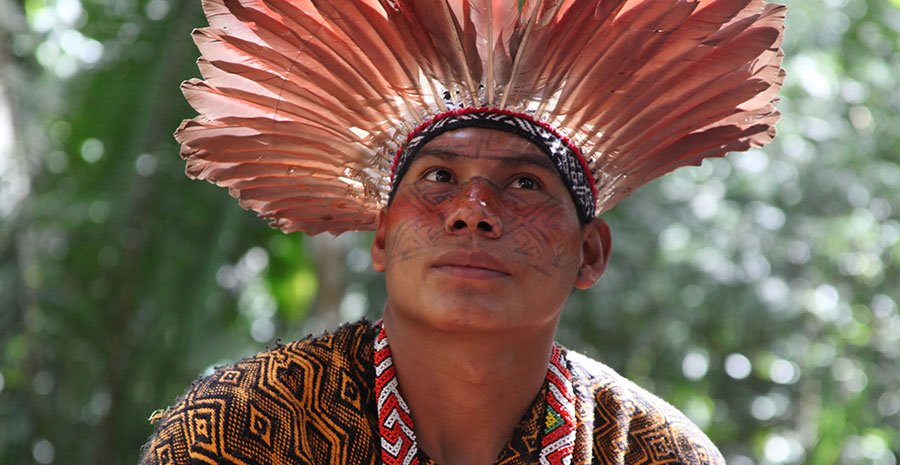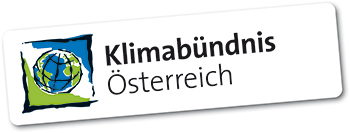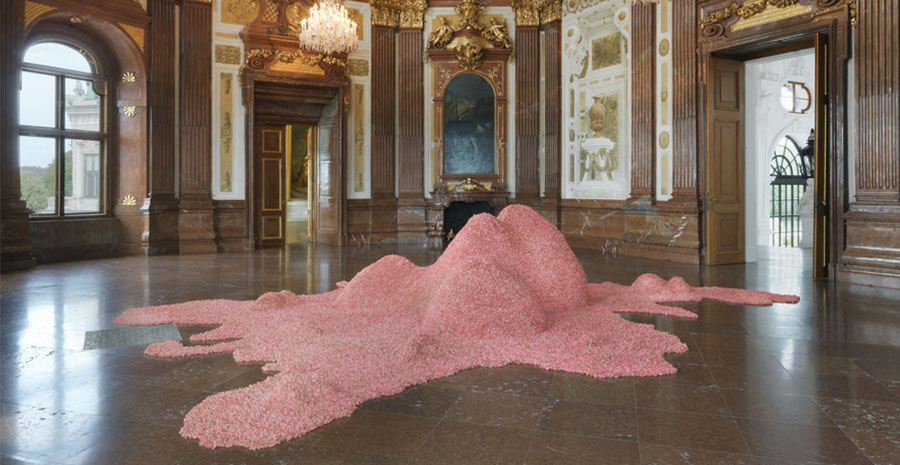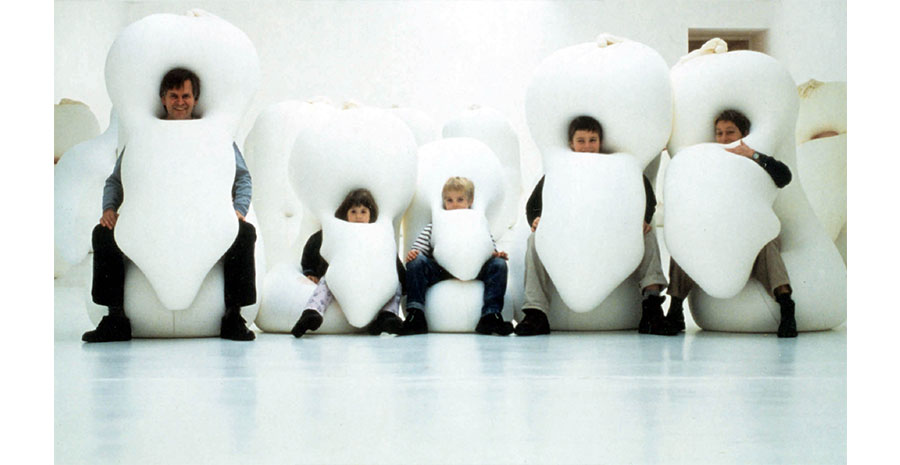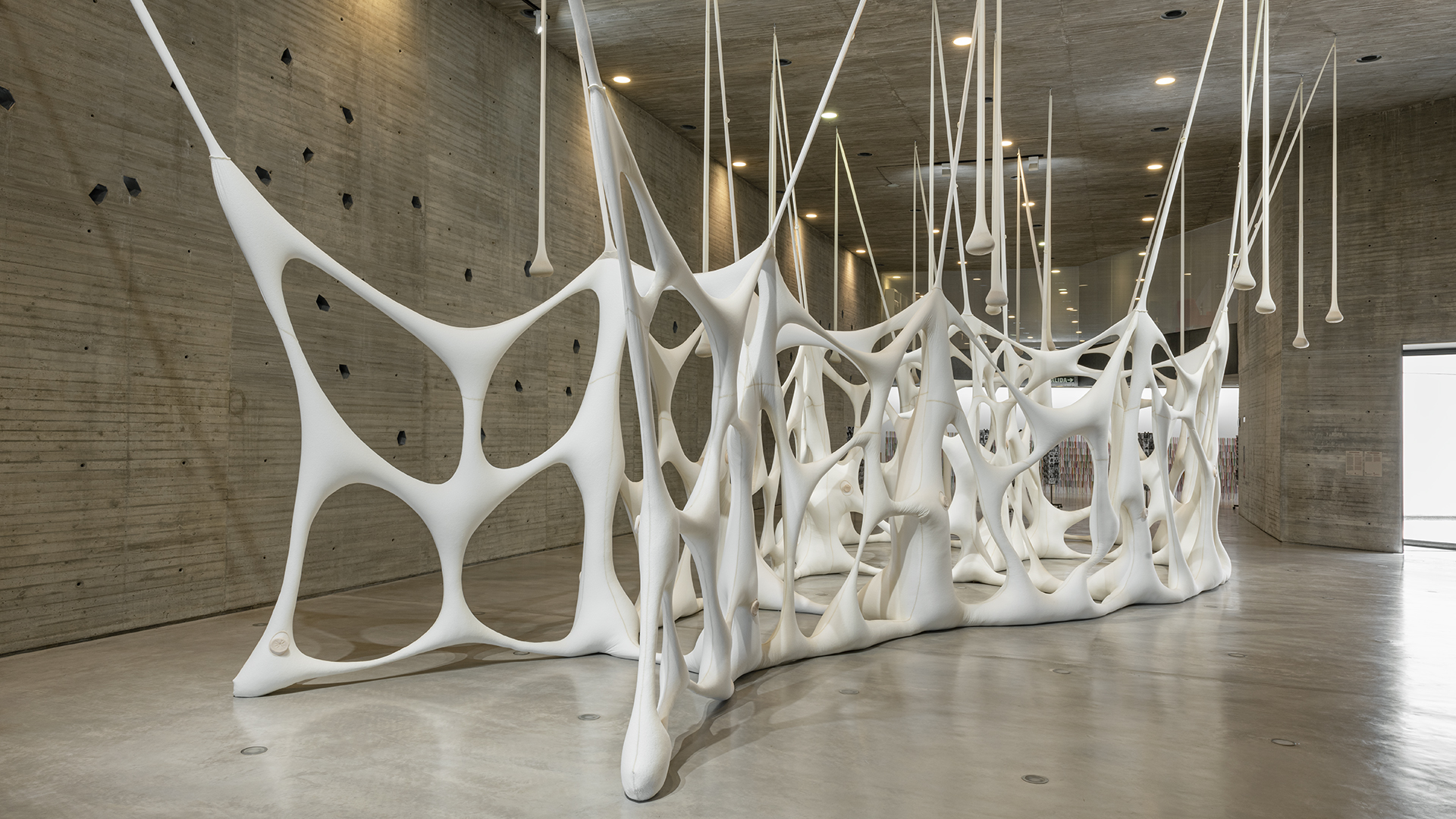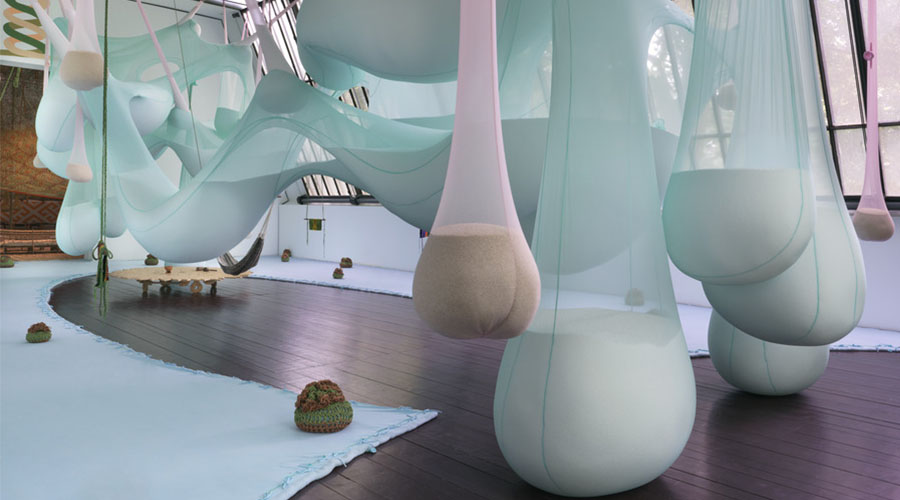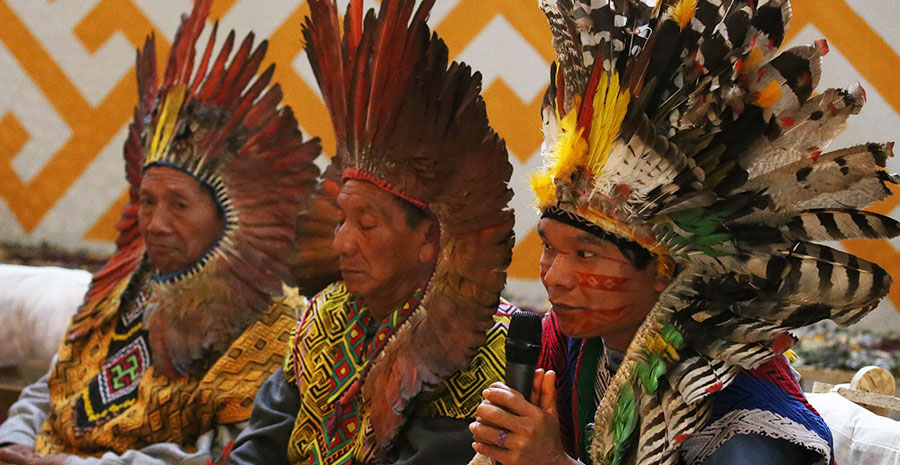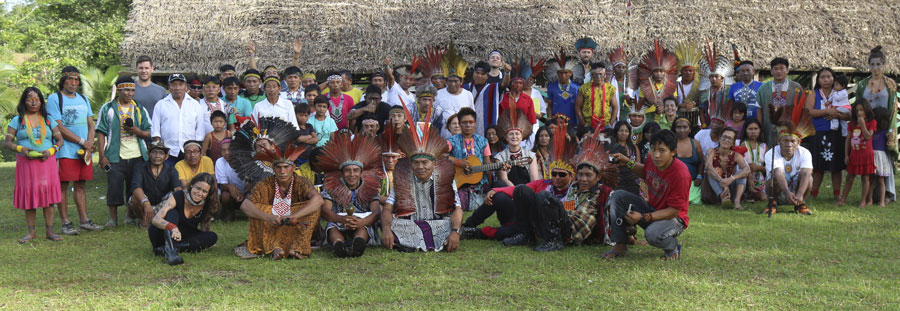Aru Kuxipa expresses the vision of the Brazilian artist Ernesto Neto and the Amazonian artists, plant masters, and pajés (shamans) of the thirty-four Jordão Huni Kuin communities to co-create a place of transformation, a zone of encounter and expression and to participate collaboratively in a joint exhibition project at Thyssen-Bornemisza Art Contemporary in Vienna. As a locus of exploration and articulation, Aru Kuxipa likewise marks an important step in an ongoing and steadily unfolding process of what the Huni Kuin call Aru Bena. Aru Bena literally means the "new" or "sacred time" and proposes a newly engaged ex-change with the world, intrinsically coupled with processes of transformation and a profound understanding of the necessity to share a common path in interconnected futures. As the Huni Kuin culture is adapting to the multi-scaled dynamics of the 21st century, this is a moment of remembering and disremembering and of political renewal. Like many indigenous peoples around the globe, the Huni Kuin have mobilized new forms of articulation and activism in the face of prevailing and new economic, legal, and ecological challenges. While they are trying to preserve their abundant ancestral knowledge and culture and to participate in dialogues with the contemporary world, we may learn from this way of life and cosmovision a more cautious and conscious interaction with the forest, the planet, and re-discover what we have come to describe "nature" as a part of us.
The program surrounding the residency of the second group of seven young leaders of the Huni Kuin in Vienna is a dynamic part of the exhibition Aru Kuxipa. It is tracing the rich ancestral knowledge and cosmovision of the Huni Kuin in their multiple expressions, engaging in novel encounters and opening the stage to new inquiries and challenges pressing specifically its younger generation at present. Each day is dedicated to a different topic of concern and engagement.
Environmental Justice and Sustainability
—Wednesday, Sept 9
In our environmental crisis indigenous peoples—witnessing increasing dangers caused by global warming, the deforestation of the Amazon, and diminishing biodiversity—are simultaneously the most effected and most vulnerable. For the great conservators and protectors of the forest it becomes increasingly impossible to sustain themselves from natural resources and live independently in the face of new environmental conditions and pollutions, such as contaminated water sources.
6 pm // Sustainability, Conservation and Environmental Justice with Johann Kandler
Johann Kandler from Climate Alliance Austria has worked intensely in Acre, the home of the Huni Kuin, where he fought for the conservation of the rainforest and environmental justice with the local communities. Environmental justice comprises a fair treatment and meaningful involvement of all people regardless their national origin and ethnic with respect to the development, implementation, and enforcement of environmental laws, regulations, and policies. How can we re-think strategies for climate change policies with the inclusion of indigenous knowledge?
7 pm // Huni Kuin: Traditional Hunting, Fishing, Agriculture and Environmental Challenges
The Huni Kuin give insight into their traditional hunting, fishing and agricultural techniques that are still fostered today, but are subject to vast changes and challenges due to deforestation, diminishing biodiversity, and economic dependencies.
Aru Bena and Aru Kuxipa
—Thursday, Sept 10
To the Huni Kuin Aru Bena, the "new"or "sacred time" means a newly engaged exchange with the world, intrinsically coupled with processes of transformation and the desire for broader contact, alliances, networks, and the need for a new common consciousness about the planet and its inhabitants. It calls for a renewed engagement with and contribution to the world at large, a time of exchange, and a striving for indigenous self-governance and sovereignty. How can we integrate this cosmovision and knowledge in a novel under-standing of interweaving relationships—ecological, cultural, political, and interpersonal relations? What is the role of the exhibition Aru Kuxipa in these mediations?
4 pm // Tour of Aru Kuxipa with Ernesto Neto and the Huni Kuin
Ernesto Neto and the Huni Kuin invite for a tour through the exhibition Aru Kuxipa—a collaboratively produced polyphonic and multi-chromatic space, sheltering Huni Kuin objects, drawings, weavings, rituals, herbaria, and celebrations in dialogue with Neto’s artistic language.
6 pm // Huni Kuin Ancestral Chants and Dances
A performative evening dedicated to the abundance of chants and dances, performed by the Huni Kuin and their rich meanings within ancestral tradition, their histories, generational transmissions, and contemporary transformations.
7 pm // Contemporary Articulations of "Tradition" with Bernd Brabec de Mori
Bernd Brabec de Mori from the Institute of Ethnomusicology at the University of the Arts in Graz discusses indigenous articulations through poetics and music while questioning ideas of authenticity and identity as they are negotiated in a changing world.
8 pm // Huni Kuin, Ernesto Neto and Pirjo Virtanen: Aru Kuxipa and Aru Bena
The presentation is followed by a conversation between Ernesto Neto, the Huni Kuin, and Pirjo Kristiina Virtanen, anthropologist and expert on Amazonian cosmovision in contemporary times, on Aru Kuxipa before the backdrop of the notion of Aru Bena: a new force and new knowledge of the ancestry at present.
The Arts of the Huni Kuin
—Friday, Sept 11
The Huni Kuin
Kené Kuin, the "true design," is an important emblem of the Huni Kuin identity, woven by women with seeds, glass pearls, and cotton or painted onto the skin with black genipapo or red annatto paint. The sacred geometric patterns are seen by Huni Kuin women in lucid states of vision. Like traditional songs, they serve as a central means of communication for and with nature, accompanying and providing the Huni Kuin with the power of animals and plants to heal, give guidance, and protect, such as the forces of the jiboia (boa).
4 pm // Kené Workshop with Maria Ayani
Maria Ayani, a great weaving master of the Huni Kuin community, holds a workshop offering an exceptional opportunity to learn about this art first hand, to hear about their meanings, histories, and mythic genesis and listen to traditional chants sung while weaving.
During the workshop, "Kené Yuxin—the turns of Kené" by Filmmaker Zenzinho Yube will be screened.
5 pm // Workshop on Body Painting
A workshop on the art of body painting. Plant ink of the annatto and genipapo are used to paint the sacred geometric designs onto the skin. These designs are a crucial element in the beauty of persons and things. Maria Ayani teaches this ancestral technique and its multitude of motifs, their histories, and powers.
7 pm // Ephemeropteræ:
EMILY ROYSDON, THOMAS RAAB
Sovereignty and Rights of the Forest
—Saturday, Sept 12
Vast areas of the Amazon are taken over by state or corporate interests, often ignoring local and indigenous peoples’ rights and claims, and delegitimizing the use of ancestral land. These "land grabbings" are repeatedly executed in the name of climate change politics such as carbon credit schemes. In Brazil a proposed law, the PEC 215 would allow for a legalization of the theft and invasion of their lands by agribusiness and multinational corporations in the name of "public interest." What idea of law legitimizes the expropriation of territory of both human and non-human beings? When is a crime a crime?
6 pm // Sovereignty and Indigenous Rights with Kristina Kroyer
Kristina Kroyer from the Department of Development Studies at the University of Vienna worked closely with the Guarani-Kaiowä regarding the loss of their land in the Mato Grosso do Sul in Brazil. The mechanisms of ”land grabbing“ and so called "green grabbing"—the appropriation of land in the name of climate change policies—make indigenous people, also beyond the territory of the Guarani, lose their habitat and the protection under communal and legal systems. These practices open up fundamental questions about the legit-imacy of national and international laws that back economic processes.
7 pm // Huni Kuin: Sovereignty of the Forest
In indigenous perspectivist ontologies, animals, plants, and many objects obtain subject positions and willing capacities, which apprehend reality from distinct points of view. The forest and plants in particular are great teachers to the Huni Kuin. They embody their very own sovereignties that categorically oppose understandings of law by state forces.
8 pm // Film Screening: "Ma Ê Dami Xina—Já me transformei em imagem" by Zézinho Yube
This film that translated into "I’ve already become an Image" by Zézinho Yube was shown at Berlin Biennale in 2015. The film narrates through the history of the Huni Kuin people and their cultural resurgence in five stages. As rubber plantation owners enslaved the Huni Kuin for decades, the community and their culture were almost extinguished. Modern methods of recording have been limited but vital to their (cultural) survival. The screening is followed by a discussion about filmmaking as a means of empowerment, articulation, and documentation of emerging contemporary issues.
Huni Kuin Culture and
Healing in Transformation
—Sunday, Sept 13
The Huni Kuin of Jordão, like many indigenous peoples around the world, have embarked on a path of (re)affirmation of their indigenous identity. They have adapted and reinvented their disrupted and almost erased cultures and knowledge in an act of (cultural) survival. The idea of fluent tradition breaks with binary ideas of authenticity/past on one hand and modernity/future on other hand and opens up questions of preservation and transmission of oral cultures and healing knowledge, evident in the Una Isi Kayawa (the "book of heal-ing")—embedded in the exhibition and conceived in a dream by the pajé Agostinho Man-duca Mateus Ĩka Muru.
1:30 pm // The Huni Kuin invite for Lunch
The Huni Kuin serve their traditional food, such as traditional peanut caiçúma soup, to sit together and share the intimacy of the kupixawa in the spirit of katxanawa, the spiritual fest of the vegetables plantation.
3 pm // Workshop on Spagyric with Max Güller
Max Güller has been devoted to herbal medicine produced by spagyric processes for 20 years. He specializes in producing particularly clear and energetic quintessences and gives an introduction to this technique to the Huni Kuin.
6 pm // Huni Kuin: Una Isi Kayawa and Forest Medicine
Members of the Huni Kuin give rare insight into their extensive healing traditions, on nixi pae (ayahuasca), shamanism, forest medicine, the understanding of curing, and the significance of visions and dreams therein. Most prominently, Una Isi Kayawa—conceived in a dream by Ĩka Muru, who has documented the sacred Huni Kuin knowledge of medicinal plants for thirty years, attempting to preserve it for future generations—exemplifies a shift from oral to written knowledge transmission and transformations healing knowledge is subject to today. The publication that resulted from Ĩka Muru’s endeavor was a collaboration between Huni Kuin pajés, the Rio de Janeiro Botanical Garden Research Institute (JBRJ), and Editora Dantes, which published the bilingual edition (in Portuguese and Hatxa Kuin) in 2014.
7 pm // The Art of Life in the Forest with Wolfgang Kapfhammer
Wolfgang Kapfhammer from the Department of Social and Cultural Anthropology at Ludwig-Maximilian University Munich is an expert in mythology and shamanism in contemporary indigenous societies, specifically in the Amazon. His most recent research has led him to the notion of "Indigenous Modernity" that lies at the core of this presentation and challenges notions of authenticity and identity with the cultural diversity of the region.
8 pm // Film screening "Livro Vivo" by Tadeo Sia and Ikamuru Huni Kuin
Livro Vivo is a film on pajé Agostinho Ĩka Muru. He takes the youngsters into the forest and teaches them how to take care of the plants that are seen as relatives of the Huni Kuin and healers of the community.
With special thanks to:
EXHIBITION:
Ernesto Neto and the Huni Kuin
Aru Kuxipa | Sacred SecretTBA21–Augarten: June 25–October 25, 2015
TBA21–Augarten
Scherzergasse 1A, 1020 Vienna
A project in cooperation with
Kunsthalle Krems and
Belvedere, Vienna Kunsthalle Krems: July 19–November 1, 2015
Upper Belvedere, Marble Hall: June 25–August 31, 2015



































